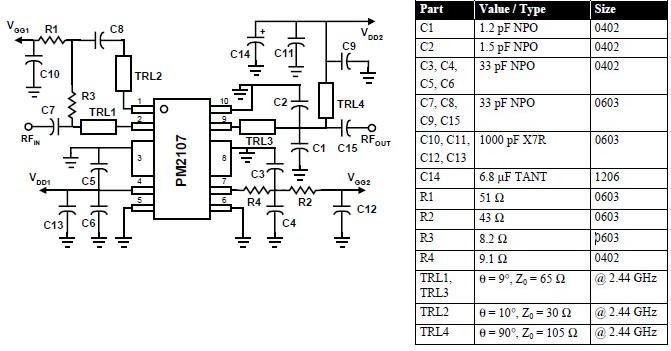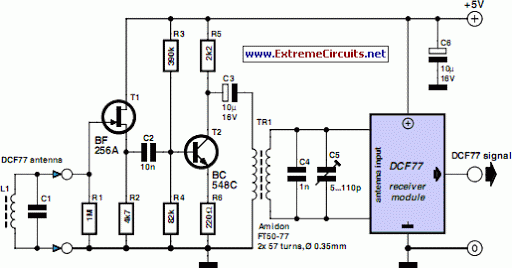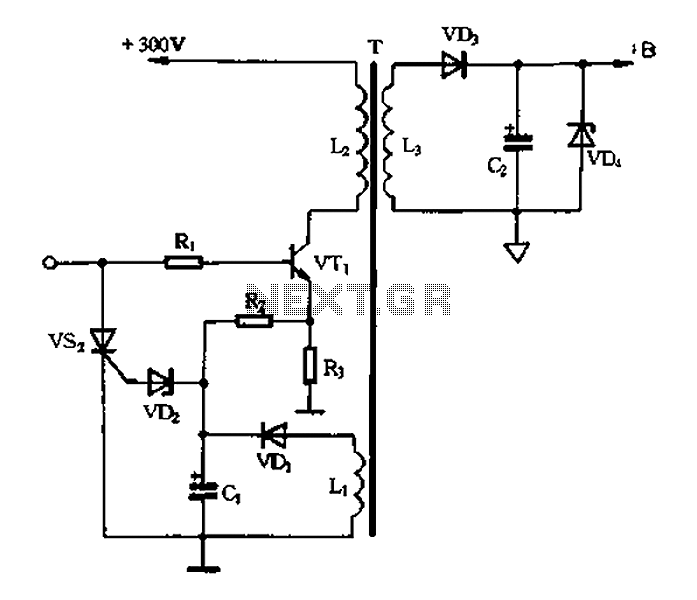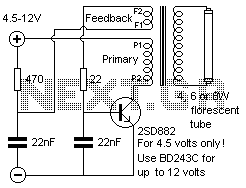
LC Meter Circuit Coil Capacitor Meter
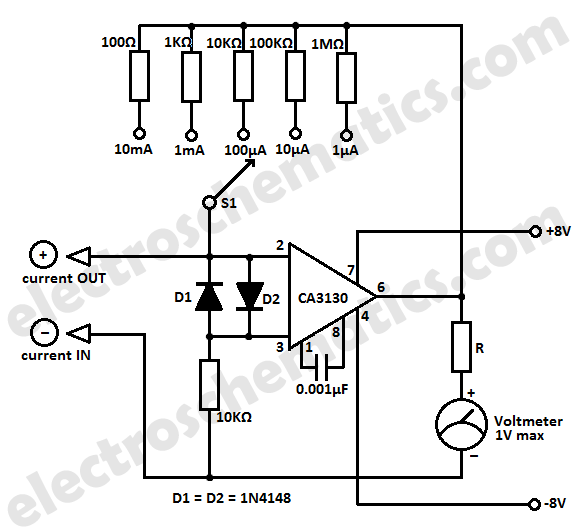
This LC meter circuit is capable of measuring inductors and capacitors. When either Lx or Cx is connected to the circuit, the oscillator frequency decreases, and this reduction is measured by a frequency-voltage converter constructed with transistors T3 and T4. The circuit can be calibrated using potentiometers P1 and P2. The precision of the LC meter is 3%. Scale calibration can be performed using the following formula: ni = nm(1 - fr)/(1 - fc), where ni represents the number of divisions measured on the scale, nm is the total number of divisions on the scale, fr is the relative frequency, and fc is the smallest relative frequency that can be measured.
This LC meter circuit operates on the principle of frequency measurement, where the frequency of an oscillator is inversely related to the values of the connected inductors and capacitors. The heart of the circuit consists of an oscillator that generates a stable frequency signal. Upon connecting an inductor (Lx) or a capacitor (Cx), the load alters the frequency of the oscillator. The resulting frequency change is detected by a frequency-voltage converter, which translates the frequency shift into a corresponding voltage level. This is accomplished using two transistors, T3 and T4, which are configured to operate as a frequency-to-voltage converter.
The circuit includes two adjustable potentiometers, P1 and P2, which are used for fine-tuning the measurement accuracy. By adjusting these components, the user can calibrate the circuit to ensure that it provides precise readings. The stated precision of the LC meter is 3%, indicating that the measurements will have a maximum deviation of 3% from the actual values.
Calibration of the scale is essential for accurate readings and is achieved through the provided formula. The formula allows the user to determine the number of divisions on the scale (ni) based on the total number of divisions (nm) and the relative frequencies (fr and fc). This relationship is crucial for ensuring that the meter provides reliable and repeatable measurements across a range of inductance and capacitance values.
Overall, this LC meter circuit is a valuable tool for electronics enthusiasts and professionals, offering a compact and efficient solution for measuring inductors and capacitors with a reasonable degree of accuracy.This LC meter circuit can measure coils and capacitors. When Lx or Cx is connected in the circuit the oscillator frequency will decrease and this decrease is measured by a frequency-voltage converter build with T3 and T4. To adjust this lc meter circuit with P1 and P2. LC meter precision is 3%. Scale calibration can be achieved with this formula: ni = nm(1 fr)/(1 fc) where ni is number of divisions measured on the scale, nm = total number of division of the scale, fr = relative frequency, fc = the smallest relative frequency measured. 🔗 External reference
This LC meter circuit operates on the principle of frequency measurement, where the frequency of an oscillator is inversely related to the values of the connected inductors and capacitors. The heart of the circuit consists of an oscillator that generates a stable frequency signal. Upon connecting an inductor (Lx) or a capacitor (Cx), the load alters the frequency of the oscillator. The resulting frequency change is detected by a frequency-voltage converter, which translates the frequency shift into a corresponding voltage level. This is accomplished using two transistors, T3 and T4, which are configured to operate as a frequency-to-voltage converter.
The circuit includes two adjustable potentiometers, P1 and P2, which are used for fine-tuning the measurement accuracy. By adjusting these components, the user can calibrate the circuit to ensure that it provides precise readings. The stated precision of the LC meter is 3%, indicating that the measurements will have a maximum deviation of 3% from the actual values.
Calibration of the scale is essential for accurate readings and is achieved through the provided formula. The formula allows the user to determine the number of divisions on the scale (ni) based on the total number of divisions (nm) and the relative frequencies (fr and fc). This relationship is crucial for ensuring that the meter provides reliable and repeatable measurements across a range of inductance and capacitance values.
Overall, this LC meter circuit is a valuable tool for electronics enthusiasts and professionals, offering a compact and efficient solution for measuring inductors and capacitors with a reasonable degree of accuracy.This LC meter circuit can measure coils and capacitors. When Lx or Cx is connected in the circuit the oscillator frequency will decrease and this decrease is measured by a frequency-voltage converter build with T3 and T4. To adjust this lc meter circuit with P1 and P2. LC meter precision is 3%. Scale calibration can be achieved with this formula: ni = nm(1 fr)/(1 fc) where ni is number of divisions measured on the scale, nm = total number of division of the scale, fr = relative frequency, fc = the smallest relative frequency measured. 🔗 External reference
